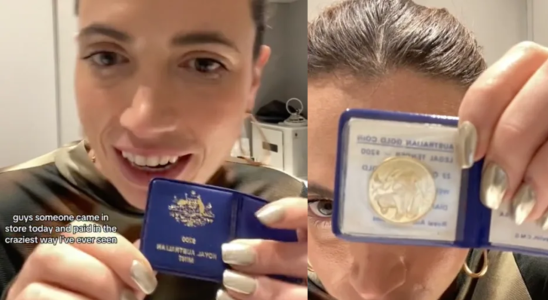Shopper turns rare coin into $1,100 discount for jewellery store: 'I would hold onto it'
By
- Replies 1
In the fascinating world of numismatics, where collectors and enthusiasts pore over the details of coins and banknotes, a piece's true value often transcends its face value.
This was precisely the case for one lucky Australian who turned a rare $200 coin into a windfall, securing a $1,100 discount on a purchase, a sum far exceeding the mere $200 a bank would have offered.
The story unfolds at Micheli Jewellery, a Melbourne store where an astute shopper presented a $200 gold coin minted back in 1983.
This isn't your everyday pocket change; it's a collector's item whose worth is tied closely to the ever-fluctuating value of gold.
Darren Harris, the owner of the jewellery store, shared the rationale behind the coin's valuation.
'If you took that coin into a bank, they would give you $200 because it's legal tender; that's the value of the coin to the bank,' he said.
'But we pay the value of the coin... and those coins have probably gone up at least 30 per cent in the last five to six months because gold's gone up so much.'
Only 88,000 pieces were produced by the Royal Australian Mint in 1983, a scarce find compared to the 186 million $1 coins struck the following year.
To put things into perspective, a $100 coin released in the same year, adorned with a Koala, has been valued at over $5,000.
It weighs an ounce or just over 28 grams.
Although the 1983 $200 coin is lighter at 10 grams, it could prove to be a lucrative investment if Harris decides to keep it.
At the beginning of the year, gold was priced at $3,038 per troy ounce (31.1 grams), and it has since climbed to $3,734. This increase bodes well for the coin's future worth.
'If you go and get a piece of [gold] bullion, it doesn't really look attractive,' Harris explained.
'If you've got a coin, it's interesting.' The coin in question was kept in a tiny plastic blue wallet, preserving its condition and adding to its collectible status.
One commenter advised, ‘This will only continue to increase in value, so I would hold onto it. My dad bought a few when they were released in the '80s. It was a very limited run. A collector will happily pay you for it,’
While another expressed hope that the coin wasn't acquired through nefarious means.
In a twist that adds to the coin's allure, it's exempt from capital gains tax (CGT), as it was minted before the introduction of CGT in 1985.
This makes it a piece of history and a tax-free asset that could be appreciated over time.
In related news, a coin collector has identified a key feature in some 1966 Australian 20-cent coins that can greatly boost their value.
Unlike the usual flat baseline, these rare coins have a wavy baseline on the number two on the tail side. You can read more about it here.
 Have you ever discovered a valuable coin or banknote in your possession? Or perhaps you have a story of an unexpected windfall from a seemingly ordinary item? Share your experiences in the comments below.
Have you ever discovered a valuable coin or banknote in your possession? Or perhaps you have a story of an unexpected windfall from a seemingly ordinary item? Share your experiences in the comments below.
This was precisely the case for one lucky Australian who turned a rare $200 coin into a windfall, securing a $1,100 discount on a purchase, a sum far exceeding the mere $200 a bank would have offered.
The story unfolds at Micheli Jewellery, a Melbourne store where an astute shopper presented a $200 gold coin minted back in 1983.
This isn't your everyday pocket change; it's a collector's item whose worth is tied closely to the ever-fluctuating value of gold.
Darren Harris, the owner of the jewellery store, shared the rationale behind the coin's valuation.
'If you took that coin into a bank, they would give you $200 because it's legal tender; that's the value of the coin to the bank,' he said.
'But we pay the value of the coin... and those coins have probably gone up at least 30 per cent in the last five to six months because gold's gone up so much.'
Only 88,000 pieces were produced by the Royal Australian Mint in 1983, a scarce find compared to the 186 million $1 coins struck the following year.
To put things into perspective, a $100 coin released in the same year, adorned with a Koala, has been valued at over $5,000.
It weighs an ounce or just over 28 grams.
Although the 1983 $200 coin is lighter at 10 grams, it could prove to be a lucrative investment if Harris decides to keep it.
At the beginning of the year, gold was priced at $3,038 per troy ounce (31.1 grams), and it has since climbed to $3,734. This increase bodes well for the coin's future worth.
'If you go and get a piece of [gold] bullion, it doesn't really look attractive,' Harris explained.
'If you've got a coin, it's interesting.' The coin in question was kept in a tiny plastic blue wallet, preserving its condition and adding to its collectible status.
One commenter advised, ‘This will only continue to increase in value, so I would hold onto it. My dad bought a few when they were released in the '80s. It was a very limited run. A collector will happily pay you for it,’
While another expressed hope that the coin wasn't acquired through nefarious means.
In a twist that adds to the coin's allure, it's exempt from capital gains tax (CGT), as it was minted before the introduction of CGT in 1985.
This makes it a piece of history and a tax-free asset that could be appreciated over time.
In related news, a coin collector has identified a key feature in some 1966 Australian 20-cent coins that can greatly boost their value.
Unlike the usual flat baseline, these rare coins have a wavy baseline on the number two on the tail side. You can read more about it here.
Key Takeaways
- A rare $200 gold coin from 1983 was used by a customer to receive a discount worth $1,100 at Micheli Jewellery in Melbourne.
- Despite being legal tender, the coin’s value was significantly higher as a collectible due to the rise in gold prices and its rarity.
- Only 88,000 of these special $200 coins were produced by the Royal Australian Mint, making them quite a collectable item.
- The coin, minted in 1983, is also exempt from capital gains tax, which was introduced in Australia in 1985, adding to its appeal for collectors.








